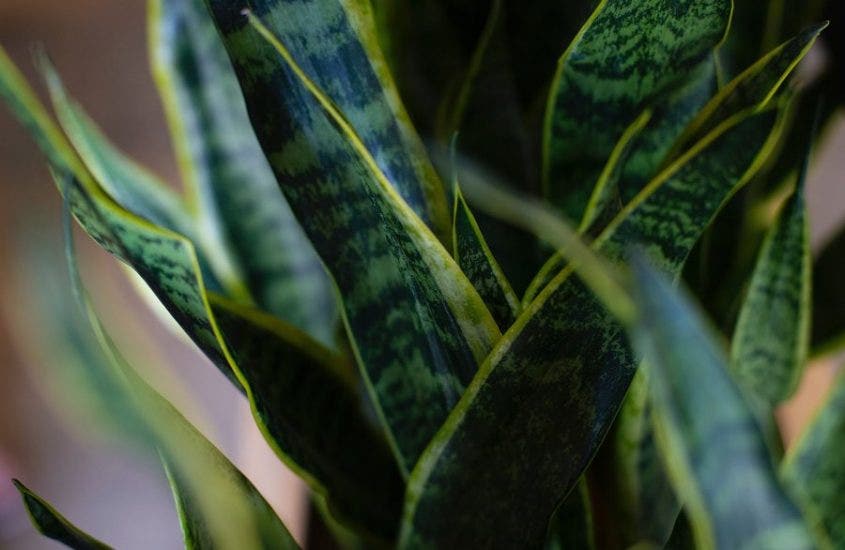How To Care For A Snake Plant

Snake plants are some of the easiest, lowest maintenance plants on the market today, but we have some helpful guidelines for you to follow to maximize the health of your snake plant!
The snake plant is becoming more and more commonplace in the household. Added to the kitchen, the bedroom, and even the bathroom, they’re flying through check-out counters and even off of online sellers. Most people think it’s treated like a succulent, but that’s not the case – we’re here to show you the best way to care for your snake plant.
We’ll show you everything we know to keep your plant in top shape. Keep reading or check out the video below!
So, snake plants generally take less water than most plants, just like succulents. They don’t need a ton of light, so placing them on your kitchen table with a bunch of windows surrounding it would be a good option. Other good places would be in your bedroom or bathroom, both near a window, but not necessarily on a window sill.
So, let’s get into some of the basics of how to care for Sansevieria trifasciata! Just grab your coffee first!
Table of Contents
What is a snake plant?
The snake plant comes from western and southern Africa, but is also found wild in more tropical climates like Florida and Hawaii, due to favorable tropical conditions. The name originates from Sansevieria trifasciata, and a common nickname for this plant is the mother-in-law’s tongue because of its sharp and pointy leaves. There are many different types.
Most snake plants feature thin, flat leaves that can be up to three inches wide and ten inches tall. If you’ve got the right conditions, yours could grow to be two or three feet! There’s also a variant called the Sansevieria patens and the Sansevieria cylindrica that have more cylindrical leaves. Depending on the plant, these leaves can be up to half an inch thick at the base and up to 8 inches tall!
Snake plants also vary in color. Some can be dark green with green tiger stripes going horizontal across the leaves, others may be green with yellow tiger stripes, and still others may be predominantly yellow with green tiger stripes. There are many different colors, so don’t feel like your color options are limited!
This pin below features lots of snake plants, so check it out!
Where to Buy Snake Plants
You can purchase a wide variety of snake plants on Amazon. Here are some of our favorites.

This 2-3 foot snake plant comes with many different pots. It’s a beautiful indoor plant for your home.
Buy your Sansevieria indoor snake plant from Amazon here.

This trio of small snake plants is a great addition to your home. Scatter them around the house or group them together to add some color to your home.
Buy your trio of Sansevieria snake plants here.

From this group of beautiful succulents, you can purchase the Sansevieria zeylanica, a popular species of snake plant. This plant is characterized by large multi-colored leaves that grow vertically.
Purchase your Sansevieria zeylanica from Amazon at this link.

Here, we have a 3 gallon snake plant – one of the largest plants from our list. The large leaves on this plant have a bright yellow outline which makes this plant a beautiful statement piece for your kitchen.
A snake plant of this size is efficient at improving your indoor air quality – in fact, it is one of a select group of air purifying plants selected by NASA.
Purchase your three-gallon snake plant from Amazon here.

Here is another four inch snake plant that is a great addition to your bedroom or family room. This snake plant is healthy and easy to maintain.
Buy yours from Amazon at this link.

The final snake plant on our list is another 4” plant, this time in a white pot. It is affordable, easy to maintain, and a full plant with several healthy leaves.
Check it out on Amazon here.
Snake Plant Care
Proper Pot Size and Drainage
It’s important to remember that you need to have a proper sized pot for your snake plant. It’s alright to have a larger pot than initially needed so you give it some space to grow. Depending on how large it gets, you might need to re pot the plant in the future.
It’s also important to have proper drainage. Some ideas for pots may not work out properly, such as an old glass container that used to be a candle. So, it’s important to remember to either craft your own drainage system or buy a pot that has proper drainage.
Light It Up! Or, Not?
There’s a bit of a discussion when it comes to how much light your snake plant needs. It’s often listed as a low light plant, so it’s perfect in places like bathrooms or your kitchen where there is not much direct sunlight.
While this is true, Sansevieria trifasciata needs some light, and, if you want it to thrive, places with high light are beautiful for it to grow like crazy!
Placing it on your window sill, or on the ground near a large window are two good options. It’ll survive under these conditions with higher light but may need more watering than if kept in a lower light place. Temperature also is key: if you live in a hot climate, like here in Utah or other desert areas and you keep it outside on a deck or porch, you may need to water it more often than if you live in a more temperate climate. Or, just keep it inside.
You can also alternate between lighting scenarios, especially if your plant appears to be dying or wilting in a low light environment.
Don’t Overwater Your Plant!
Remember that snake plants are succulents, even though sometimes they can have big “leafy” looking limbs. They will need minimal amounts of water – only every couple of days! Some people use a spray bottle.
Another rule of thumb is to water it when the soil is dry. Touch the dirt with your finger, and if it’s dry or crumbling easily, that’s a sign you need to water your plant.
Good Soil, Good Life!
Having good soil or potting mix for your snake plant is essential to its survival. When you buy your plant, generally there will be a tag that explains what type of potting soil it has. It will sometimes come with fertilizer, which we’ll touch on in a minute.
If your snake plant doesn’t come with a tag, here’s the best type of soil to get. An African violet soil mixture is usually the best type of soil and there’s an easy way to make your own. Use one part garden soil, one part peat, and two parts sand; the sand is needed to help with drainage!
Sometimes it’s hard to find the exact soil you need in stores, or the soil is sold in extreme bulk. Instead, try investing in making your own soil for all your plants which may be a cheaper option in the long run!
For fertilizing your snake plant, once a month is a good time frame, especially in spring and summer months. Generally, fertilization in winter months is not necessary since plants grow slower in colder months, but you could fertilize it once during the winter months if you wanted. Just note that most people abstain in the wintertime, and will see lots of growth when fertilized in spring and summer months!
Now, let’s get into some fast-paced FAQs, Q&A style!
How often do you water a snake plant?
Every 2-3 days is just fine. You can also touch the soil, and if it is dry or crumbly, water your plant. If you have a larger snake plant, you may need to water it more often or give it more water.
Are snake plants easy to take care of?
Yes! They’re one of the hardest plants to kill. Provide sunlight every day and water every 2-3 days. With the best snake plant care, it will likely live for many years. Remember to change the soil, water it on time and regularly, and to allow for ample amounts of sun.
Why is my snake plant dying?
You may be overwatering your plant or it may not have enough sun exposure. Try moving it to a different part of your house, or even outside if it isn’t too hot or cold, and see if it revives itself! You can also try changing out the soil with fresh soil.
Do all snake plants clean the air?
They actually do! Besides producing lots of oxygen, it can absorb harmful toxins like formaldehyde, xylene, benzene, and toluene. As a rule of thumb, plants with bigger leafs or more surface area, excel at this.
Should I mist my snake plant?
This is up to you! Some people would rather use this method to combat overwatering. You can use this method and spray it with mist every day, or add one cup of water every 2-3 days.
How do you know if your snake plant is overwatered?
Root rot is a tell-tale sign of overwatering. The solution here is pretty simple: repot it with fresh soil and prune any mushy leaves. Watch the amount of water you give your plant and drain any excess water immediately.
Do snake plants need sunlight?
All plants need sunlight to survive and grow, but the amount can vary. If you want to grow it larger, lots of sunlight is the best solution for you. If you keep it in a bathroom or bedroom with minimal light, it likely will not grow much. Just remember that the amount of sun exposure positively correlates with how much water you will need to give your plant.
Related Articles
6 Ways to Incorporate Indoor House Plants
What is a snake plant?
The snake plant comes from western and southern Africa, but is also found wild in more tropical climates like Florida and Hawaii, due to favorable tropical conditions. The name originates from Sansevieria trifasciata, and a common nickname for this plant is the mother-in-law’s tongue because of its sharp and pointy leaves. There are many different types.
How often do you water a snake plant?
Every 2-3 days is just fine. You can also touch the soil, and if it is dry or crumbly, water your plant. If you have a larger snake plant, you may need to water it more often or give it more water.
Are snake plants easy to take care of?
Yes! They’re one of the hardest plants to kill. Provide sunlight every day and water every 2-3 days. With the best snake plant care, it will likely live for many years. Remember to change the soil, water it on time and regularly, and to allow for ample amounts of sun.
Why is my snake plant dying?
You may be overwatering your plant or it may not have enough sun exposure. Try moving it to a different part of your house, or even outside if it isn’t too hot or cold, and see if it revives itself! You can also try changing out the soil with fresh soil.
Do all snake plants clean the air?
They actually do! Besides producing lots of oxygen, it can absorb harmful toxins like formaldehyde, xylene, benzene, and toluene. As a rule of thumb, plants with bigger leafs or more surface area, excel at this.
Should I mist my snake plant?
This is up to you! Some people would rather use this method to combat overwatering. You can use this method and spray it with mist every day, or add one cup of water every 2-3 days.
How do you know if your snake plant is overwatered?
Root rot is a tell-tale sign of overwatering. The solution here is pretty simple: repot it with fresh soil and prune any mushy leaves. Watch the amount of water you give your plant and drain any excess water immediately.
Do snake plants need sunlight?
All plants need sunlight to survive and grow, but the amount can vary. If you want to grow it larger, lots of sunlight is the best solution for you. If you keep it in a bathroom or bedroom with minimal light, it likely will not grow much. Just remember that the amount of sun exposure positively correlates with how much water you will need to give your plant.







Comments are closed.